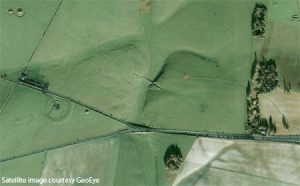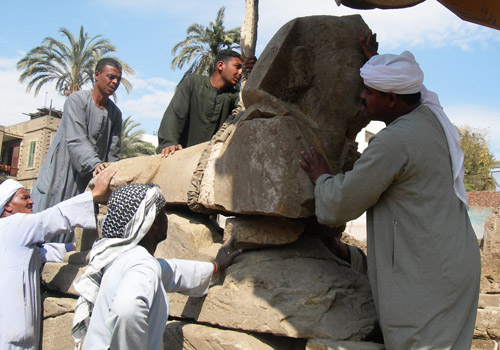A second henge has been discovered near Stonehenge, less than one kilometre away from the iconic stone circle. A cutting edge archaeological survey (view images), part of the ‘Stonehenge Hidden Landscapes Project‘ has uncovered the henge-like monument. Because of the circular monument’s shape, the archaeologists believe the henge to be contemporary to Stonehenge. The henge comprises of a segmented ditch, surrounded by a ring of pits up to one metre in diameter. It is possible the pits held a free-standing timber structure and inside the circle is a burial mound, which was added later. With two entrances on the north-east…
-
-
Archaeologists at the University of Birmingham are heading to Stonehenge to lead the Britain’s biggest-ever virtual excavation, a far from superficial look at the Stonehenge landscape. The Stonehenge Hidden Landscapes Project will use the latest geophysical imaging techniques to visually recreate the iconic prehistoric monument and its surroundings as it was more than 4000 years ago.Update 22/07/2010 First result is the discovery of a henge, about 900m from Stonehenge itself. Magnetometer images & photos here. The Stonehenge Hidden Landscapes Project, started early July, aims to bring together the most sophisticated geophysics team ever to be engaged in a single archaeological project in Britain to work alongside specialists…
-
Archaeologists excavating in the Guatamalanjunglehave discovered a royal tomb, filled with colourful 1,600-year-old Mayan artefacts, beneath the El Diablo pyramid. The well preserved tombis packed with carvings, ceramics, textiles, and the bones of six children, possibly the remains of a human sacrifice. The archaeological team, led by Stephen Houston, professor of anthropology at Brown University, uncovered the tomb beneath the El Diablo pyramid in the city of El Zots, Guatamalain May. Last week, the discovery of the tomb, dated to between 350 and 400AD, was made public. Houston said the first pointer to the discovery was something odd in the…
-
A unique piece of 4,500-year-old rock art has been unearthed in the Cambridgeshire village of Over. The prehistoric slab of sandstone is unlike anything previously found in Eastern England. The hand-sized neolithic artefact, which possible dates back as far as 2,500 BC, was found at Needingworth Quarry by Open University student Susie Sinclair. Intothe stone’ssurface, two pair of concentric circles are etched, typical of late Neolithic ‘Grooved Ware’ art. Researchers do not know if the motif represents a type of meaningful art, or if it is nothing more than Neolithic doodling. Examples of similar Grooved Ware art have been discovered…
-
The BBC has officially announced its TVschedule for this autumn and winter, promising its audience a big focus on history, with new programmes and new presenters. What to expect from the Beeb this autumn and winter, when the rain and cold keeps you locked into your home? The autumn & winter 2010/2011 programming includes ‘Behind Closed Doors’ with Amanda Vickery, ‘The Do-Gooders’ with Ian Hislop and programming to mark the Battle of Britain’s 70th anniversary, with a drama-documentary based on Geoffrey Wellum’s book, First Light. Ancient history specials served on these coldand dark winter nights will be ‘Pompeii’with Mary Beard,…
-
Archaeologists excavating at Ahnasia in Upper Egypt, have unearthed the remains of a 3,300-year-old temple built by pharaoh Ramesses the Great. According to a statement released by the SCA, excavations at Ahnasia, an archaeological area in Beni-Suef, recently uncovered remains of a temple that can be dated to the reign of 19th Dynastyking Ramesses II . Dr. Sabri Abdel Aziz, Head of the Pharaonic Sector in the SCA, said that inside the remains of the New Kingdom temple, excavators uncovered ten cartouches of Ramesses II and beneath them a relief saying that the ruler had ordered the construction of this…
-
An Italian study of the plaster casts of the 79 AD Vesuvius eruption victims showsmost were not suffocated by ash, as is often assumed. Neither were they knocked down by fast-moving currents of hot gas. Rather, the extreme heat was the main cause of the instantaneous deaths at Pompeii. At temperatures up to 300C, the unfortunate citizens, including those seeking shelter inside buildings, were cooked alive. Italy, 79 AD. Vesuvius erupts, throwing up a high-altitude column from which ash began to fall, blanketing Pompeii and surrounding areas, and creating an invaluable archaeological record,preserved for almost 2,000 years. It is estimated…
-
Sir Andrew Lloyd Webber, the multi-millionaire musical impresario, has expressed a wish to purchase Highclere Castle, near Newbury, Berkshire. The Victorian castle has been the family seat of the Carnarvons since the 1670s, and was home to the fifth Earl of Carnarvon, who funded Howard Carter’s discovery of Tutankhamun‘s tomb (watch the video). Andrew Lloyd Webber’s offer came after the current Earl applied for permission to sell pieces of land on the fringes of the Highclere estate in the hope of raising 11 million to fund badly-needed repair works to the Victorian mansion. In a letter sent to the Earl…
-
When the latest Tutankhamun study was published in Jama, there were quite a few outcries that although the study looked into the direct ancestry of King Tut, it fully ignored the pointers to the pharoah’s racial ancestry, possibly hidden in the pharaoh’s DNA. As usual, Dr Zahi was accused of many things, most notable charges of ‘hiding that King Tut was black/white/purple.’ Now a retired physicist took the time to write down some of the DNA test results exposed in the Discovery Channel programme that featured the study’s results and concluded the data shown in the docu reveals Tut’s haplogroup…
-
Archaeologists have unearthed twelve ancient sphinx statues at Luxor, Egypt. The sculptures were found at a newly discovered part of the Avenue of Sphinxes, an ancient road stretching from the temple at Karnak to the temple of the goddess Mut at Luxor. The discovery, made as part of excavation and restoration works at the site by the Supreme Council of Antiquities (SCA), was announced by Egypt’s Minister of Culture, Farouk Hosni. The statues of the mythical creatures, inscribed with the name of Pharaoh Nectanebo I, were found in the last sector of the Avenue of Sphinxes, a part of the sacred…


